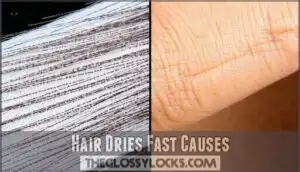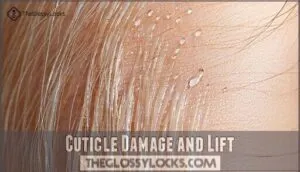This site is supported by our readers. We may earn a commission, at no cost to you, if you purchase through links.

Things like heat styling, harsh products, or even sun exposure can cause this. Overwashing strips away natural oils, while chemical treatments can weaken your hair’s structure.
Environmental factors like wind or dry climates don’t help either. High-porosity hair often feels frizzy, brittle, or tangled.
Thankfully, moisturizing products, gentle care, and protective habits can make a big difference. Curious how? Stay tuned for easy, game-changing tips!
Table Of Contents
- Key Takeaways
- Hair Dries Fast Causes
- Why Hair Dries So Fast
- High Porosity Hair Issues
- Hair Care Routine Impact
- Managing Quick Drying Hair
- Frequently Asked Questions (FAQs)
- Why does my hair dries so fast?
- What could be the reason for slow hair growth?
- Why is my hair so dry?
- Why does dense hair take a long time to dry?
- Why does my hair dry faster if I live in an arid climate?
- Why does my hair dries so fast after a shower?
- Does healthy hair dry quicker?
- How do I stop my hair from drying so fast?
- How does the change of seasons affect the drying time of my hair?
- Can dietary changes impact how quickly my hair dries?
- Conclusion
Key Takeaways
- Your hair dries quickly because of high porosity, which lets moisture escape fast due to damaged cuticles, heat styling, or environmental factors.
- Overwashing and harsh shampoos strip your hair’s natural oils, increasing porosity and moisture loss.
- Protect moisture with deep conditioning, leave-in treatments, and sealing oils like argan or coconut.
- Limit heat styling, wear hats or scarves against sun and wind, and use heat protection to prevent further damage.
Hair Dries Fast Causes
Your hair dries quickly when its protective cuticle layer has been damaged by heat styling, chemical treatments, or environmental factors like sun exposure and dry climates.
High porosity hair struggles to retain moisture because water enters and exits the hair shaft rapidly, leaving you with strands that feel dry shortly after washing, which is a result of high porosity.
Environmental Factors
Surrounded by invisible forces, your hair constantly battles environmental factors that cause it to dry at surprising speeds.
Environmental exposure substantially affects how quickly moisture escapes from your strands.
The main culprits include:
- Humidity Levels – Low humidity environments (like winter weather or desert climates) actively pull moisture from your hair, leaving it parched
- Sun Exposure – UV rays damage your hair’s protective cuticle layer, making it harder to retain moisture
- Wind Damage – Constant air movement increases evaporation and roughens hair surface
Climate impact varies seasonally, with hair drying fastest during dry winter months or in arid regions.
Pollution effects can also deposit harmful chemicals on your strands, further compromising their ability to retain moisture.
Hair Structure Damage
Your hair’s structure is like armor that protects moisture when intact.
Damage to this armor—your hair cuticles—is a major reason why your hair dries so fast.
When cuticle layer damage occurs, your hair shaft can’t keep moisture locked in.
Chemical treatment impact is particularly harsh, breaking down the proteins that give your hair structure.
This leads to increased hair porosity, allowing water to escape quickly.
Hygral fatigue effects compound the problem as your hair repeatedly swells with moisture then dries out.
The result?
Elasticity reduction, hair breakage, and strands that dry in record time.
Lack of Moisture
A thirsty scalp leads to hair that dries quickly. When your strands lack proper moisture, they can’t retain water effectively, especially if you have high porosity hair.
Five key signs of moisture loss:
- Hair feels rough within hours of washing
- Ends appear brittle and straw-like
- Strands snap easily when stretched
- Products seem to "disappear" shortly after application
- Hair becomes staticky with minimal friction
Using humectants, deep conditioning treatments, and natural oils can improve your hair’s hydration strategies while avoiding product buildup that worsens moisture retention.
Overuse of Heat Styling
Beyond inadequate moisture, your constant use of heat styling tools is making your hair dry fast.
Each time you blast your strands with blow dryers or clamp them between hot straighteners, you’re causing significant heat damage. These high temperatures disrupt your hair’s cuticles and trigger protein loss, leading to moisture depletion.
Your hair becomes more porous, unable to hold hydration.
Try implementing preventative measures like heat protectants and lower temperature settings to minimize cuticle damage and slow down drying time.
Why Hair Dries So Fast
Inside your strands lies the mystery of why your hair dries so fast.
Hair porosity explained: your cuticles can’t trap moisture effectively, allowing quick moisture escape.
Here’s why your hair might be drying quickly:
- High porosity creates pathways for water to exit rapidly
- Environmental impact from dry, windy climates accelerates moisture loss
- Product buildup forms barriers preventing proper hydration
- Hair thickness and age affect natural oil distribution
Understanding these factors helps you identify solutions for your fast-drying hair.
Different drying techniques and addressing hard water issues can substantially improve moisture retention in your strands.
Low porosity hair, for example, resists water absorption, which is related to hair porosity and can be influenced by environmental impact and product buildup.
High Porosity Hair Issues
Your hair dries quickly because the cuticle layer has gaps or holes that allow moisture to escape rapidly, a condition known as high porosity.
If you notice your strands absorb water fast in the shower but feel dry within minutes after toweling off, you’re likely dealing with damaged cuticles that can’t retain moisture effectively, which is often related to damaged cuticles.
Prone to Frizz
When your hair dries unusually fast, frizz often becomes your unwelcome companion due to high porosity hair‘s inability to retain moisture.
This frustrating phenomenon stems from:
- Cuticle roughness that prevents proper moisture sealing
- Humidity’s impact creating moisture imbalance between hair and environment
- Rapid moisture escape through damaged cuticle layers
- Product buildup that blocks healthy hydration
With each strand’s raised cuticles acting like open doors, moisture constantly escapes while environmental moisture tries to enter, creating that characteristic frizzy halo effect around your head.
The combination of these factors leads to an inability to lock in moisture, resulting in unwelcome companion of frizz and an overall lack of hair health, which can be attributed to the inability to retain moisture.
Dryness and Brittle Hair
While frizz might be your first concern, the dryness and brittleness that comes with high-porosity hair creates deeper problems.
Your hair’s damaged cuticles can’t seal in moisture, leading to constant hair dryness and rapid moisture escape.
Without this essential hydration, you’ll experience elasticity loss, increased hair breakage, and persistent split ends.
The dull appearance and rough texture changes become more noticeable with each passing day.
Think of your strands like a leaky bucket—no matter how much moisture you pour in, it escapes quickly.
Implementing dry hair problem solutions starts with understanding your hair porosity and addressing the issue of constant hair dryness.
Tangled and Rough Texture
Beyond brittle strands, high porosity hair presents another challenge: tangled and rough texture. Your raised cuticles create significant hair roughness, causing strands to snag together and form stubborn hair tangles.
When your hair dries quickly, this texture issue worsens. Moisture absorption becomes uneven, amplifying frizz and diminishing shine.
For texture improvement, try using a wide-tooth comb for hair detangling and apply pre-shampoo treatments for added slip. This hair type benefits from regular deep conditioning to restore moisture.
For overnight protection, wrap your hair in a silk scarf to prevent friction and minimize cuticle roughness.
Cuticle Damage and Lift
While tangled hair makes brushing difficult, your cuticle structure might be why your hair dries quickly.
Think of damaged cuticles as tiny open doors that can’t keep moisture inside.
Your hair’s quick-drying issues stem from:
Raised cuticles and environmental stressors cause rapid moisture loss, leaving your strands dry, brittle, and thirsty for hydration.
- Lifted cuticles allowing rapid moisture escape after washing
- Environmental aggressors breaking down protective layers
- Chemical damage creating more pathways for moisture loss
- Rough texture indicating significant cuticle lift
- High hair porosity making strands unable to retain hydration
These factors contribute to the overall health and appearance of your hair, with moisture loss being a key concern.
Hair Care Routine Impact
Your daily hair care choices directly affect how quickly your hair dries, from the products you use to your styling methods.
The combination of overwashing with harsh shampoos, excessive heat styling, and insufficient conditioning creates a perfect storm that can leave your hair strands depleted of natural oils and moisture, which is a critical factor in hair care.
Overwashing and Harsh Products
Regarding hair drying too quickly, your washing habits might be the culprit. Overwashing strips your hair’s natural oils, disrupting your scalp oil balance. Most commercial shampoos contain harsh sulfates that accelerate moisture stripping from the hair shaft.
| Product Ingredient Impact | Hair Damage | Solutions |
|---|---|---|
| Sulfates | Removes natural oils | Sulfate-free shampoos |
| Parabens | Weakens hair strands | Natural alternatives |
| Alcohol | Dries out scalp | Oil-based products |
| Silicones | Creates buildup | Gentle cleansing options |
Try reducing your wash frequency to 2-3 times weekly. Between washes, use dry shampoo to absorb excess oil while maintaining your hair’s natural moisture balance. Switching to shampoos without sulfates can help retain moisture. Using sulfate-free shampoos and natural alternatives can also be beneficial for your hair health, reducing the risk of hair damage and promoting a healthy scalp oil balance.
Chemical Treatments and Heat Styling
When you color, bleach, or perm your hair, these chemical treatments dramatically increase hair porosity by lifting the cuticle layers.
Your hair’s natural moisture barrier gets compromised with each salon visit, causing it to dry unusually fast afterward. Heat styling compounds this damage—flat irons and blow dryers set above 320°F literally evaporate moisture from your strands.
To minimize styling effects on drying time, always use heat protection products before styling, limit treatment frequency to every 8-10 weeks, and choose gentler product options with moisturizing ingredients. Consider lower heat settings and invest in high-quality tools that distribute heat more evenly.
To combat this, incorporate deep conditioning masks into your routine, using them as part of a strategy to reduce hair porosity and promote natural moisture barrier recovery.
Lack of Conditioning and Moisturizing
While many people occasionally skip conditioning, this habit creates a serious moisture imbalance that drastically speeds up hair drying time. Your shampooed hair desperately needs replenishment of the protective oils it loses during washing.
Maintaining proper hair hydration requires:
- Using conditioners with beneficial ingredients like fatty alcohols and shea butter
- Implementing effective hydration methods such as deep conditioning treatments
- Establishing a consistent hair moisturizing routine without causing product buildup
Quality conditioning products seal your cuticles, preventing rapid moisture escape and maintaining scalp health. Many people find success with specialized conditioning products. Think of conditioner as your hair’s daily drink of water—without it, your strands become like parched plants in the desert, unable to retain essential moisture and becoming increasingly brittle.
Improper Use of Styling Tools
Beyond conditioning, your styling tools might be causing your hair to dry too quickly.
The way you use heat styling equipment directly affects your hair’s moisture levels.
| Tool Issue | Impact on Hair Drying Speed |
|---|---|
| High Temperature | Damages cuticles, increases porosity |
| No Heat Protection | Allows direct heat damage to strands |
| Product Buildup | Transfers residue that blocks moisture |
| Incorrect Distance | Too close contact intensifies heat damage |
| Overexposure | Extended heat contact dries inner moisture |
Using lower heat settings and applying protective sprays before styling can substantially slow the hair drying process and prevent long-term heat damage to your strands.
Many people use specialized hair products to mitigate heat damage.
Managing Quick Drying Hair
You can effectively manage hair that dries too quickly by implementing specific moisture-retention strategies that address your hair’s high porosity.
Your daily routine should include reducing shampoo frequency, using rich conditioning treatments, and protecting strands from environmental stressors.
Maintaining regular trims to prevent further damage to your hair’s cuticle structure is also crucial.
Reducing Shampoo Frequency
If your hair dries too quickly, your washing routine might be the culprit. Reducing shampoo frequency helps your scalp maintain its natural oils that seal in moisture.
Here’s how adjusting your wash schedule helps control hair drying speed factors:
- Every wash strips protective oils, increasing hair porosity and moisture loss
- Using dry shampoo between washes prevents scalp buildup without drying
- Co-washing (conditioner washing) cleanses while preserving hydration balance
- A 2-3 day gap between shampoos allows your hair’s natural moisture barrier to rebuild
This adjustment can significantly impact your hair’s health by allowing it to regain its hydration balance and reducing the need for frequent washing, which in turn helps to prevent moisture loss.
Using Moisturizing Products
Now that you’re shampooing less, let’s boost your hair’s moisture retention with the right products.
For fast-drying hair, apply leave-in conditioners to wet strands for better absorption. Layer products using the humectant-first approach—start with water-attracting ingredients, then seal with plant oils like argan or coconut.
Deep conditioning weekly fills gaps in high porosity hair, while daily leave-ins maintain hydration.
For color-treated strands, choose moisture-rich, color-safe formulas that won’t strip your investment, using the right products to boost your hair’s moisture retention with a color-safe approach.
Protecting Hair From Sun and Wind
Now that you’ve upgraded your moisturizing routine, don’t let outdoor elements undo your good work.
Daily sun and wind exposure can strip your hair’s moisture faster than you might realize.
Defend your quick-drying strands with:
- Physical barriers like hats or scarves that shield your scalp from direct UV hair damage
- Leave-in products containing UV filters to create an invisible shield
- Tucked-away styles that minimize windblown hair breakage while maintaining hydration
Regular Trimming and Conditioning
To maintain moisture balance in fast-drying hair, don’t skip regular trims every 6-8 weeks.
These trims prevent split ends from traveling up the hair shaft, promoting healthy hair growth while reducing dryness.
Complement your hair care routine with different conditioning types: use deep treatments weekly for intensive repair, and leave-in conditioners daily for consistent moisture retention.
Many find success using a microfiber hair wrap to reduce drying time.
Your hair drying speed improves when you address both external damage and internal hydration needs. This two-pronged approach creates the foundation for healthier hair ends that won’t dry out so quickly.
Frequently Asked Questions (FAQs)
Why does my hair dries so fast?
Fast hair drying often comes from high porosity, which lets water escape quickly.
This happens with damaged cuticles, heat styling, or aging.
Environmental factors like low humidity or fine hair strands can also speed things up, related to the concept of porosity.
What could be the reason for slow hair growth?
About 50% of hair growth issues relate to poor scalp health.
Stress, nutrient deficiencies, hormonal imbalances, or over-styling can slow growth.
Treat your scalp like a garden—healthy roots grow stronger, longer hair.
Why is my hair so dry?
Your hair feels dry because it loses moisture quickly due to damaged or porous cuticles, harsh products, or heat styling.
To help, focus on deep conditioning, avoid harsh shampoos, and use oils to seal moisture.
Why does dense hair take a long time to dry?
Did you know dense hair contains thousands more strands per square inch?
This creates a barrier, slowing airflow and trapping water.
Picture it like a sponge—it absorbs plenty, making drying feel like forever!
Why does my hair dry faster if I live in an arid climate?
In an arid climate, the dry air speeds up water evaporation from your hair.
With little moisture in the atmosphere, your strands lose water quickly, leaving your hair dry faster than usual.
Why does my hair dries so fast after a shower?
Your hair dries so quickly because of high porosity, damaged cuticles, or environmental factors.
Gaps in the cuticle let water in and out fast.
It’s like a sponge that absorbs water but can’t hold it.
Does healthy hair dry quicker?
Healthy hair typically dries slower because its cuticles are intact, holding onto moisture longer.
Faster drying often points to porous or damaged hair, where gaps in the cuticles let water escape more easily.
How do I stop my hair from drying so fast?
Limit heat styling, use deep conditioners, and seal moisture with oils like argan or coconut.
Try the **L.O.C.
** method and avoid alcohol-based or sulfate-heavy products.
Microfiber towels and cooler temperatures during drying can help too.
How does the change of seasons affect the drying time of my hair?
Seasonal changes impact your hair’s drying time by altering humidity levels.
In winter, low humidity makes hair dry faster, while summer’s moist air slows it down.
Indoor heating or air conditioning also affects moisture retention, and understanding these factors can help you manage your hair’s drying time more effectively.
Can dietary changes impact how quickly my hair dries?
Believe it or not, what you eat can play a role.
Nutrient deficiencies, like low protein or essential fatty acids, weaken your hair, making it prone to damage and faster moisture loss.
Balance helps your strands thrive!
Conclusion
If your hair dries too fast, it’s like a thirsty plant that can’t hold water—it’s all about porosity.
High-porosity hair may feel frizzy or brittle, but with small changes, you can revive it.
Avoid over-styling, switch to moisturizing products, and shield your strands from harsh elements.
Reduce shampoo use, try deep conditioners, and trim split ends often.
Understanding "why does my hair dry so fast" is the first step to healthier, happier locks, and it’s crucial for achieving happier hair through proper care.














